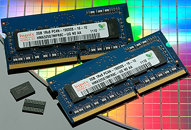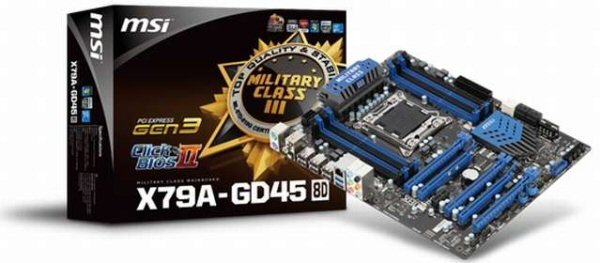ACard's ANS-9010 Serial ATA RAM disk
Solid-state storage from another angle
by
Geoff Gasior — 11:08 PM on January 20, 2009
[TABLE="align: right"]
<tbody>[TR]
[TD]
<tbody>
[TD="width: 70, bgcolor: #616B94"]
Model
[/TD]
[TD="width: 155, bgcolor: #515C8C"]<nobr>
ANS-9010
</nobr>[/TD]
[TD="width: 70, bgcolor: #616B94"]
Price (Street)
[/TD]
[TD="width: 155, bgcolor: #515C8C"][/TD]
[TD="width: 70, bgcolor: #616B94"]
Availability
[/TD]
[TD="width: 155, bgcolor: #515C8C"]
Now
[/TD]
</tbody>
[/TD]
[/TR]
</tbody>[/TABLE]
Solid-state storage is the new hotness. Of course, that hotness is relative—this is still the storage market we're talking about. Think less Scarlett Johansson and more Tina Fey. Nonetheless, the recent almost-affordability of blazing-fast flash drives has been an interesting development in the storage world. And it's getting even more interesting, because in addition to an entire family of flash drives, the SSD market also has a crazy uncle.
The focus of most solid-state storage discussions centers on flash-based solutions, but they're not the only game in town. DRAM chips offer solid-state storage, too, and they're widely available on plain old memory modules. What's more, even Intel's fastest X25-E flash drive is limited to 250MB/s reads and 170MB/s writes, but your average DDR2-800 DIMM can read and write at up to 6.4GB/s. That's like lining up a 40-horsepower motor ripped from a Vespa against the W16 monstrosity that powers the Bugatti Veyron.
[TABLE="align: right"]
<tbody>[TR]
[TD][/TD]
[/TR]
</tbody>[/TABLE]
Of course, you still need a way to get DRAM chips to behave as a hard drive. The hardware to do so was initially offered only for high-end servers and workstations, and it was priced accordingly. Then, about
three years ago, Gigabyte went out on a limb with an i-RAM storage device that allowed users to plug four DIMMs into a PCI card that hooked up to a standard Serial ATA port. The i-RAM was ridiculously fast, and for most intents and purposes, it behaved exactly like a normal hard drive.
The original i-RAM's total capacity was limited to 4GB of DDR SDRAM, so it's not particularly useful by today's standards. However, a company called ACard has done one better with the ANS-9010 RAM disk, which has eight DDR2 DIMM slots and support for up to 8GB of memory per slot. The ANS-9010 also features a pair of Serial ATA ports, allowing it to function as a single drive or masquerade as a pair of drives that can easily be split into an even faster RAID 0 array. Can this latest RAM disk live up to its staggering performance potential, and perhaps more importantly, could you live with it as a primary hard drive?
The difference DRAM makes
Before taking a closer look at the ANS-9010, I should date myself by noting that the RAM disk concept is really nothing new. Those who have been around for a while will remember that sectioning off a chunk of system memory for storage was all the rage back in the day. RAM disks were a software solution back then, so they used memory already plugged into your motherboard. The move to hardware-based RAM disks has made things much easier by allowing users to access memory modules through a standard hard drive interface without the need for drivers or even an operating system.
So why use DRAM over the flash memory everyone and their mother seems to have their fingers in? Speed, for one. I've already mentioned DDR2's 6.4GB/s transfer rates. However, that 6.4GB/s is just a theoretical peak. The Serial ATA interface is currently limited to 300MB/s, and even with both its SATA ports active, ACard only claims transfer rates up to 400MB/s for the ANS-9010.
Another benefit DRAM has over flash memory is that there's no limit on the number of write-erase cycles it can endure. Effective wear leveling algorithms and single-level cell memory can greatly improve the lifespan of a flash drive, but they just prolong the inevitable. DRAM's resiliency does come with a cost, though. While flash memory cells retain their data when the power is cut, DRAM is volatile, so it does not. To keep DRAM data intact, you have to keep the chips juiced.
Evolving the RAM disk
Storage solutions generally aren't much to look at, but the ANS-9010 is a little different. Instead of being tucked away in an internal hard drive bay, it slides into an external 5.25" optical bay where you can see it.
The device's front panel has a few ventilation slits and is littered with indicator lights for power, drive access, and battery life. ACard equips the ANS-9010 with a 7.4V, 2400 mAh battery that keeps the drive's memory powered when the host system is shut off. Our battery was able to keep 16GB of memory powered for more than four hours, which isn't nearly good enough if you want to turn your system off at night, but more than enough to get through the occasional reboot or hardware upgrade.
For those who would rather not trust a battery with preserving their data, the ANS-9010 also features a CF card slot up front. With the push of a button, the drive can back up or restore the contents of its memory to a flash card. This backup capability might seem like a small thing, but it greatly improves the RAM disk's usability in the real world. ACard quotes a CF backup time of 21 minutes and 34 seconds for a 32GB configuration and a restore time of just over 14 minutes for the same config.
Busting the ANS-9010 open reveals eight 240-pin DDR2 DIMM slots. ACard says module densities up to 8GB are supported, bringing the drive's total capacity potential up to an impressive 64GB. Keep in mind that 8GB memory modules are extremely expensive, though. For most folks, cost alone will limit the drive's total capacity to 32GB or less. ACard doesn't yet list any 8GB modules on its
memory compatibility list, either. You'll want to pay attention to that compatibility list, because registered and ECC DIMMs aren't supported. It also took a couple of firmware revisions for the ANS-9010 to get along with the OCZ DIMMs we used for testing.
The RAM disk's DIMM slots are arranged in pairs of four, with spacing similar to what you'd find on a motherboard. This leaves just enough room for modules with normal heatspreaders, although taller DIMMs may bump their heads on the 5.25" drive bay ceiling. You can still run taller DIMMs by removing the ANS-9010's top panel, and as long as you don't have a 5.25" drive in the bay directly above, most cases should be accommodating.
Between the rows of DIMM slots sits the RAM disk's battery and really the only silicon of note. Hidden under a passive heatsink sits a FPGA chip that ACard has programmed to make the memory modules behave as a hard drive. As Intel's X25-series SSDs have illustrated, a good storage controller architecture can significantly improve performance. ACard isn't saying much about the ANS-9010's storage controller design, but we'll soon see whether it's made the most of the prodigious bandwidth potential inherent to DDR2 memory.
We do know that ACard's storage and memory controller has at least one interesting trick up its sleeve—it's able to split installed memory between two physical Serial ATA ports. Even with only a single DIMM installed, the ANS-9010 can present itself as two physical hard drives via two SATA ports located at the rear. This feature allows users to wring even more performance from the drive by pairing it with a RAID controller for a little striped RAID 0 love. And because solid-state storage is immune to the mechanical failures that make running RAID 0 dicey with traditional hard drives, you don't have to worry about a head crash hosing the array.
Switching the ANS-9010 between single-drive and RAID modes requires flipping a jumper, which is accessible from the rear. Otherwise, there isn't much to see. The drive pulls juice from a standard Serial ATA power cable, although it only seems to draw from the 12V line.











